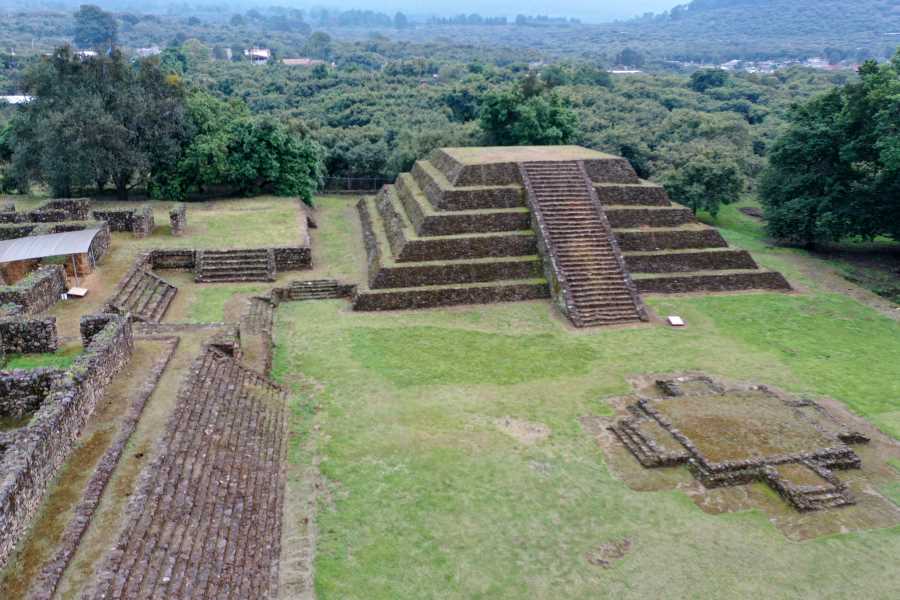Tingambato and the Mystery of Its Abandonment
Archaeologists and geophysics team up to reveal how the ancient city of Tingambato thrived for almost a millennium before being mysteriously abandoned around 900 AD. Could a nearby volcano be the culprit?

Thanks to archaeological investigations and the work of the National Archaeomagnetic Service (SAN) of UNAM at the archaeological site of Tingambato, Michoacán, it was revealed that the area had an occupation from around the year 0 to 900 AD and, coincidentally, The abandonment of the site is contemporary with the birth of the El Metate volcano.
Avto Gogichaishvili, Juan Julio Morales Contreras and Nayeli Pérez Rodríguez, from the SAN; In addition to José Luis Punzo Díaz, from the National Institute of Anthropology and History (INAH), in charge of the project, they detailed that the study integrates several specialists, and a fundamental aspect has to do with the dating, since it is one of the great doubts that they had until now.
“This opens the doors for us to better understand what life was like at that time, around 900 AD. This period is very important in regional archeology, since significant changes are observed in the social structure, which in the Tingambato region coincides with the eruption of the volcano. Which generates new research questions that will involve studies and work to advance the construction of this puzzle of the past,” said Punzo Díaz.
The site is one of the most relevant in western Mexico as it is a bridge between the regions of the Balsas River with the center of the country. It has two pyramidal mounds, a ball court, altars, a palace-type complex and four tombs: the first was discovered in the 19th century, it is extremely rich in terms of found objects (which was looted); the second discovered in 1979, with approximately 120 people buried with hundreds of objects; another in 2012 with 19 thousand pieces as an offering (one of the largest in the region); and the most recently found in 2018, the archaeologist said.
The experts pointed out that, despite the knowledge of the area, there was no absolute chronological data that reliably defined the chronology of Tingambato, so the archaeomagnetic and magnetic mineralogy study on fragments of its ceramics allowed us to delve deeper into the history of the place.
In turn, Pérez Rodríguez explained: although the site has three stages of occupation, approximately 300 years each, the investigation focused especially on the abandonment stage (from 600 to 900 AD), since according to the investigations archaeologically there is information that the city was vacated due to a fire. It must be remembered that within the cosmology of pre-Hispanic cultures, fire was considered a deity.
In this regard, Juan Morales added that in the studies carried out on the El Metate volcano, evidence was found that its activity began between the years 990 and 1130 AD, so it is possible that the abandonment of the ancient city of Tingambato was caused by this situation.
The city is located within the region known as the Michoacán-Guanajuato volcanic field, where more than 1,500 volcanic buildings are concentrated, which began to form approximately 5 million years ago, he added.
The academic from the Institute of Geophysics, Unidad Michoacán, added that there is no evidence that the volcano — which covered an area of more than 100 square kilometers — has had a direct impact on Tingambato, since its activity was characterized by the emission of lava and not of large eruptive columns.
When this process began, several towns were surely buried, whose populations had to emigrate. The social and environmental stress that was experienced could have been the cause of the departure of the inhabitants of Tingambato, he said.
“Nayeli studied not only the Tingambato ceramics, which is an archaeological artifact, but also the lava flows of the El Metate volcano, which is located a few kilometers from the archaeological site; Therefore, the results that we propose from abandonment are also based on the study of volcanic material. Metate is a monogenetic type volcano, similar to Paricutín, which also caused the displacement of the town of San Juan Parangaricutiro in 1943, something similar could have happened in Tingambato, but on greater magnitudes,” Gogichaishvili reiterated.
Punzo Díaz pointed out that the latest dates we have of occupation of the site correspond with the dates that were made for the eruption of the volcano, and now we know that the last years of occupation practically coincide with the birth of this volcano. This work adds to the investigations that are already being carried out with other materials, such as plant remains and Carbon 14, which allows better understand what happened in this place.


A restored section of a pyramid at Tingambato, with lush green mountains in the background. Credit: UNAM




